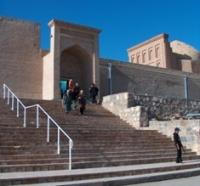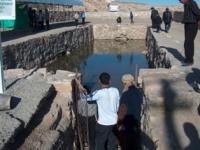You are here
Sultan Uvais.




Tourist bus routes in Karakalpakstan.
"Why is the Almighty Creator of our bodies
Didn't you want to give us immortality?
If we are perfect, why die?
If they are imperfect, then who is the bungler? "
Omar Khayyam.
Ancient settlements of Karakalpakstan.
Sultan Uvays (his real name is Suhail ibn Omir ibn Rushon ibn Nohiyya ibn Murod), a representative of the Murordiy tribe, who lived in the village of Qaran in Yemen, was born in 625. troops of Mu'awiyah. He was buried in the village of Sofa in Syria.
Sultan Uvais became famous for collecting and studying hadith. His followers erected a symbolic mausoleum in his honor and turned it into a place of worship. Sultan Weiss, according to legend, was a friend and associate of the Prophet Muhammad and came to Central Asia to spread Islam.
Islam, which established itself in the lower reaches of the Amu Darya in the Middle Ages, in order to overcome the ancient pagan cults, spread in these places the cult of Wais al Qarani, a Yemeni shepherd who became one of the first followers of the Prophet Muhammad.
Dedicated to him After the death of Sultan Weiss, a long tombstone was built over his grave, corresponding, according to legend, to his height. And in the 9th century, a mausoleum with a mosque was erected over the burial, around which Muslims began to be buried.
Sultan Uvais was a simple camel herder and came from the village of Qaran in Yemen. He was a contemporary of the Prophet Muhammad and is considered in some Islamic circles as the founder of the Islamic Sufi movement.
Early Islamic records state that while living in Yemen, Wais al-Qarani internally received the teachings of the Prophet and became a devout Muslim. He was inspired to travel to Medina to meet the Prophet Muhammad.
His mother, who was blind, gave him permission to leave on the condition that he returned immediately as soon as he reached the Prophet's house. After three months of travel, he arrived in Medina, but the prophet was not at home. True to his promise, he returned to Yemen.
Despite this, Sultan Vais did not meet with the Prophet, He always came to him in a dream. He often said, “I feel the breath of the Merciful who comes to me from Yemen.” Shortly before his death in 632, the Prophet ordered his two closest companions Omar (who later became the second caliph) and Ali (the husband of the Prophet's daughter Fatima) to take their cloak and give it to Wais in Yemen.
This laid the spiritual foundation of Wais al-Qarani in the Islamic faith. Although he did not have any special training, he was declared a saint and is revered by believers to this day. It is unlikely that Wais al-Qarani is buried in these mountains that bear his name today.
Similar tombs, associated by the name with Wais al-Qarani, can be found in two places in Syria, namely Damascus and Ar-Raqqa, and in another close to Zabid in Yemen. Vais probably died between 656 and 657.
According to the ethnographer G.P. Snesarev, even during the Soviet era, the Sufi order Uvaisiya, one of the most mysterious in Central Asia, continued to operate actively in the area of Sultan Bobo. It was especially honored not only by sheikhs-mentors, but also by Nazir - children whom, even before their birth or after a serious illness in infancy, their parents gave up for life-long service in the sanctuary.
Such children were considered to be something like the spiritual sons of Uvays al-Qarani.
Pilgrims visiting Sultan Wais Bobo refuse to recognize the mausoleum as a kadamgoh (symbolic place of visit). According to legend, after the death of Uvais, seven rulers of different countries challenged the honor of burying his remains on their land, but at dawn the body of the holy martyr mystically ended up in all seven tabuts (funeral stretchers) sent for him.
Local legends link the wonders of Uvais al-Qarani with the very origin of the Karatau mountains. When Uvais grazed his flocks, they reported that the Prophet Muhammad had one tooth knocked out by a stone in the battle with the infidels at Mount Okhod, the righteous also wished to lose a tooth.
But since he did not know which tooth Muhammad had lost, he knocked out all 32 of his teeth. Another legend about the Battle of Siffin says that when the enemies surrounded Hazrat Ali, Uvays came to his aid. He grabbed 96 stones in the floor of his robe and began to throw them at enemies.
As soon as he threw one stone - and many enemies were killed at once. When he scattered all the stones, the enemy hordes were defeated to the last warrior. Sheikhs-caretakers of the Sultan-bobo sanctuary, retelling this legend to the ethnographer Gleb Snesarev in the 70s of the XX century, argued that these amazing events took place not in Syria, but in the Sultanuizdag mountains.
By the mid-2000s, the legend already said that the Karatau mountains themselves were formed from knocked out teeth, with which Uvais al-Qarani threw the enemy. In a less fantastic version of the same legend, not the mountains themselves are called the teeth of the saint, but only the ancient ones in the gorge next to the sanctuary.
According to local beliefs, Uvais al-Qarani is able to control the climate, mitigate drought and regulate water levels in wells, multiply yields and influence the fertility of livestock. People with various kinds of diseases, including congenital and mental ones, are often brought to his mausoleum.
Experts point out that in Central Asia, Uvais al-Qarani, a former Yemeni shepherd, also plays the role of a special patron of camels and camel breeding. In Turkmenistan he is called Veyis-baba, and in Kazakhstan he is known as Oysyl-Kara.
Literature:
1. Snesarev G. P. "The relics of pre-Muslim beliefs and rituals among the Uzbeks of Khorezm." M., 1969. - 336 p., "Under the sky of Khorezm." Ethnographic essays. M., 1973. 160 p., "Khorezm legends as a source on the history of religious cults in Central Asia." M., 1983.S. 80-100.
. Attar Farid ad-Din. "Tales of the Saints." M .: Sampo, 2005.240 p.
3. Chalisova N. Yu. “The Aroma of Uvays al-Qarani in Persian Poetry and His Life”, “Remembrance of Friends” by Attar. RGGU Bulletin, No. 3. Series “History. Philology. Culturology. Oriental Studies ". M., 2015.S. 74-94.
4. Idris Shah. "Sufism. Classical teachers ". M., 1994.S. 407.
5. "Mythological Dictionary". Barn-she. M. Soviet Encyclopedia, 1991. P. 36.
6. Alexey Chernyak. "Cult complex Sultan Uvais Bobo (southern slope of the Sultanuizdag mountain range." Karakalpakstan, Uzbekistan. // http://life-on-earth.ru/tsentralnaya-aziya/sultan-uvajs-bobo
7.Andrey Kudryashov. "Sacred mountains Sultan Uvais". Sacred places of Uzbekistan. The saint's teeth turned into mountains. Fergana: https://fergana.media/photos/115871/
8. Travel to Khorezm. Part VI. Sultan Uvays-Bobo. https://mytashkent.uz/2016/05/11/puteshestvie-v-horezm-6/
Authority:
https://ru.wikipedia.org/wiki/%D0%A1%D0%B2%D1%8F%D1%82%D0%
Photos by
Alexander Petrov.







